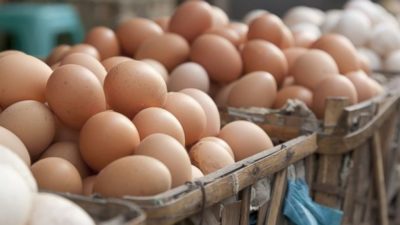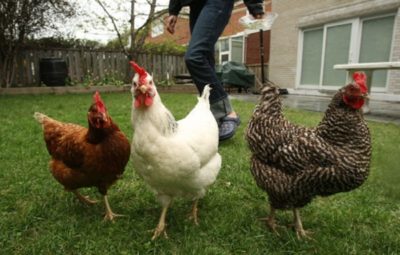So you’ve decided that backyard chickens would be a good addition to your self-sufficient lifestyle. Now comes the more difficult part. What exactly are you going to do with those chickens you see scratching and nesting in your mind’s eye? Are you raising them for eggs only? Maybe you are remembering those expensive, fancy breeds shown at county fairs.
Why not raise them for some extra cash? If that interests you, then keep reading.
Before you get started, consider:
1. Is it legal for you to raise backyard chickens where you live — and to sell?
In rural areas this might not be an issue. However, it is always smart to check just in case your county or state has some obscure regulation regarding raising backyard chickens and all that enterprise entails. In urban areas there is almost always some ordinance or regulation regarding the raising of livestock within city boundaries. Roosters are often banned within city limits, so that would mean you couldn’t breed your own line of show birds.
2. Do you need a permit to build your chicken coop and run?
This is definitely necessary to find out if you are within city limits, since you could be required to pay a fine and remove the unpermitted building or addition.
3. Do you have enough space for backyard chickens?
Figure at least four square feet per bird for the coop and eight square feet per bird for the run. We’ll discuss this more a little later in the article.
4. What kinds of predators are there?
In the city you may have to deal with rats, raccoons, opossums, feral or stray cats and dogs, and the occasional troublemaking human. I live within township limits and I have seen foxes during the day and heard coyotes at night. You may have these same problems depending on the size of your town/city and your location within it.
Hawks, eagles, owls, weasels and snakes also can cause problems if your homestead is located in smaller townships and villages.
In true rural areas you will encounter larger predators like wolves, bears, badgers, bobcats, etc., depending upon the region you live in.

Fresh eggs from backyard chickens are delicious
5. What age of chicken will you buy? How long do you want to wait for eggs, good-sized carcasses, or to be able to show your bird?
Chicks require a bit more work to raise. If you can’t keep them warm enough they will die. Chicks are somewhat delicate and you will wait at least six months for eggs and up to a year for them to be full adult size and ready for butchering. As far as ornamental birds go, you could wait up to three years for them to be ready to compete. Another potential problem is that you can’t really tell if you are getting male or female chicks because vent-sexing is only about 90 percent accurate.
Pullets are about 20 weeks old and are just a couple weeks away from laying eggs. If you buy pullets to start your flock you will know you are getting all hens as the adult feathers are growing in and are distinctive between male and female. This is the most popular way of raising backyard chickens. This is the age that most ornamentals are purchased and some county fairs have a pullet class, meaning you can begin showing your bird as soon as the chicken has settled into its new home.
Mature hens are difficult to find. However, you can occasionally find farmers willing to sell their “old biddies” to you. Keep in mind, however, that these birds are past their prime laying years. Mature show chickens can be quite expensive, especially if they are considered to be bred from champions of their breed.
Eggs, Meat, or Show?
Once you have found out or considered the information above you are ready to decide whether you are raising these chickens for eggs, meat, both eggs and meat, or for show birds. The care for the birds is similar, though show birds tend to be more delicate and require extra care and more extravagant housing.
The first thing to think about when choosing the types of chickens to raise is related to where you live. The climate in your area will be the biggest deciding factor in choosing the breed of chicken you can most easily raise in that area. Once you have determined the seasonal differences, you are ready to research which chickens will do best in your region.
Backyard Chickens Raised for Food
The table below lists the chickens that are raised for egg production in a backyard setting, the approximate number of eggs per week you will get from each bird of that breed, and the color of the eggshells. All of the breeds listed in the table are cold-hardy birds, though you may need to offer some form of heat in the coop if temperatures dip below what is the norm for your region.
Breed |
Egg Laying | Egg Color |
| Australorp | 5/week | Brown |
| Rhode Island | 5/week | Brown |
| Red or Black Star | 5/week | Brown |
| Chantecler | 4/week | Brown |
| Delaware | 4/week | Brown |
| Easter Eggers | 4/week | Multi-colored |
| White Leghorn | 4-6/week | White |
| Plymouth Rock | 4/week | Brown |
| Wyandotte | 4/week | Brown |
| Ameraucana | 3/week | Light Blue |
| Holland | 3/week | White |
| New Hampshire Red | 3/week | Brown |
| Orpington | 3/week | Brown |
| Redcaps | 3/week | White |
| Java | 3/week | Brown |
As you can see from that table most of the chickens raised for eggs are dual purpose. That means that once their egg-laying days are over, they can provide a meal for your family. You should remember that chickens can live from 10 to 14 years but will only lay the projected amounts in the table between the ages of one and three to four years. After that, egg laying will taper off until your chicken is laying only one or two eggs each week.
Learn How ‘God’s Miracle Dust’ Can Keep Your Livestock Healthy
Other things that will affect your hen’s egg laying are winter, molting, crowding and illness. You can’t really do anything to increase laying in winter so just be aware that as the days grow cooler and shorter your hens may not give you as many eggs. Molting occurs in most breeds starting at about 18 months of age. A molting bird will look terrible since they lose most if not all of their feathers during this period, which can last from two to four months. Egg laying will resume about a week after the bird’s feathers grow back in. Crowding occurs when you have too small a space to contain your flock. To be comfortable and happy each chicken needs the proper amount of space to roost, nest and scratch.
In the table above – with the exception of the Easter Eggers, White Leghorns and Ameraucana breeds – the chickens were bred to be layers as well as roasters or fryers. The breeds listed in that table will weigh between five and eight pounds at their full adult weight and will dress out to a four- to seven-pound carcass.
Backyard Chickens Raised for Profit
Show chickens, also known as ornamental birds, require slightly more care than the breeds used as layers and meat producers. You will need to be sure that their coop is much cleaner since mites and lice will detract from their looks. These birds will molt so they won’t be able to be shown or sold as show birds during this time. I suggest that you do a lot of research before investing in your choice of an ornamental breed. However, if you do choose to raise an ornamental breed, or several, they can bring in a nice profit on each chick, pullet or chicken sold.
Below is a list of 11 of the most popular breeds used as ornamental or show birds. You may choose one of these more popular breeds or take a risk on raising a rarer breed. It is a myth that ornamental chickens don’t lay eggs. Of course they do, since all birds lay eggs. However, their eggs are much smaller than chickens bred for egg-laying. The eggs are are edible if they are gathered shortly after being laid.
11 Popular Ornamental Breeds
- Brahma. This breed is called “The King of All Poultry.”
- Cochin.
- Favorolle.
- Cubalaya.
- Java.
- Orpington.
- Silver Phoenix.
- Dominique.
- Langshan. These birds can fly fairly high, so build your fences accordingly.
- Malay. These chickens stand two- to three-feet tall!
- Dutch Bantam.
Egg Layers and Meat Birds
Your egg layers and your meat birds can earn you money as well if you have a large enough flock to support that effort. Two to four birds will provide enough eggs each week for your family and probably have enough left over to give away to friends. However, if you have a large enough flock and raise your chickens properly, during the summer months you can make a tidy profit at the farmer’s market or selling to your neighbors.
It is thought that about half of the backyard farmers or homesteaders that raise backyard chickens sell their excess eggs. Eggs from chickens that are raised with grain or corn supplemental feed sell for about $2 per dozen. Eggs from chickens that are either free-range or eat only grass, vegetable waste from your kitchen and bugs are considered organic can sell for as much as $5 or more per dozen. If you are raising your chickens for meat, you also can sell the butchered carcass at the farmer’s market or to your neighbors. Corn- or grain-fed chickens sell for about $3 per pound. Free-range or organic-fed chickens can sell for around $5 per pound.
And then there are the “heritage breeds” that are raised for meat. These carcasses can sell for more than $5 per pound since their meat is tasty and tender. One thing to remember if you are raising meat chickens to sell: Butcher them at the earliest time after they have reached their full adult weight. If you butcher chickens older than two years of age, they are no longer “roasters” and are only good for stewing due to the meat not being as tender. Roasters bring in the most profit, although “stewers” or “soup” birds can still be a nice money-maker during the winter months.
 Off The Grid News Better Ideas For Off The Grid Living
Off The Grid News Better Ideas For Off The Grid Living





